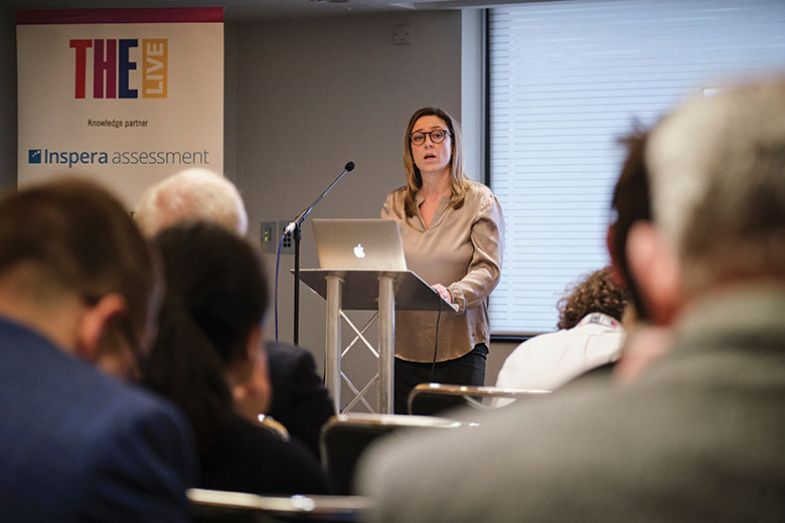
Source:
THE

Across Scandinavia, pressure from students has resulted in higher education institutions adopting technology-based modes of testing – might the UK be next?
The chain of events that resulted in the Scandinavian higher education sector becoming a world-leading adopter of digital assessment began on campus at the University of Oslo in 2011. Students campaigned for the use of computers in examinations on the grounds that they used them in everyday life and in their teaching, and so for them not to be able use their devices in examinations was unfair.
Sofie Emmertsen, executive e-assessment advisor for Inspera, the leading European provider of digital examination solutions, said that students had lost the penmanship required for written examinations, placing them at a disadvantage at the most critical moments of their academic career. Inspera's UK partners include the universities of Oxford and Bath, BPP University and Cambridge Assessment.
Dr Emmertsen led the discussion at the THE Live 2019 session “Transforming assessment via digitisation: key learnings from the pioneers”. During her opening speech, she charted the rise in popularity of digital assessment across Scandinavia and, in the question and answer session that followed, she addressed concerns from delegates, offering a pathway for digital assessments to be adopted in the UK.
“The claim was that students could no longer handwrite for three, four, five or six hours,” said Dr Emmertsen. “Many of them had lost the skills to write by hand and produce anything that was legible for the markers and academics.”
It was a very simple problem, and universities across the region collaborated on finding a solution: a new model for assessment that would enable students to use computers in an exam environment. But, in exploring the solutions to the students’ request, universities found that the issue was more complicated, or at least had depths to it that brought into question the entire architecture of university assessment.
“This is where authentic assessment comes into play,” said Dr Emmertsen. “What is authentic assessment? Well, if you take a very standard definition from a dictionary, you will see that authentic assessment is a set of methods and techniques for assessing the academic achievements of a student that includes activities requiring the application of knowledge and skills to real-world situations, and that is often seen as an alternative to standardised testing.”
This meant a shift away from exam formats, such as multiple choice, in favour of a fresh approach to exam authoring. Dr Emmertsen contextualised this shift and the pursuit of authentic assessment within the wider issues surrounding student satisfaction. “Many of those we spoke to at conferences would say that they are trying to make their assessments more interactive, more fun, more engaging,” she said. “It’s about student experience and it’s about student satisfaction.” The problems that universities faced were technological. How can you secure an examination when you let electronic devices into the hall? How would such a system be accessible to all? Would different disciplines require different solutions?
Companies such as Inspera had to find the answers and deliver a solution that could support credit-bearing examinations at all stages. Dr Emmertsen described Inspera’s service as end to end, facilitating the authoring of examinations, the front-end software for students to sit the exam, and then software to support whichever marking workflow was used by the institution.
“We support all the processes around exam planning – exam paper authoring, academics authoring the contents of the assessments in collaboration or on their own,” explained Dr Emmertsen. “We support invigilation, for invigilators doing part of the security check. Other provisions for security are provided by the software – a locked-down browser, etc – and, of course, marked-down workflows.
“We support online marking. It can be very formal or informal: blind marking, double-blind marking, moderated marking.”
Dr Emmertsen admitted that although the students are “overwhelmingly happy” with digital assessments, as are university administrators, those marking exams were the hardest user group to convert. It has taken time to move marking from the page to the screen, and each university has its own way of working.
“The technology is not the problem,” says Dr Emmertsen. “The problem is the practices, and we still need to have print buttons for markers who need to print everything that they have done before, to punch grades into Excel sheets and upload like that.”
Those teething problems have largely been ironed out in Scandinavia. Dr Emmertsen believes that markers now see the benefits of having their workflow all in one place. By moving to digital forms of assessments, universities can all but eliminate the risk of a lost test paper.
Using digital modes of assessment also allows for the efficacy of examinations to be monitored over a period of time. “We comply with psychometric standards for educational test construction,” said Dr Emmertsen. “That essentially means that we have support for the measuring of item performances, and that will allow academics to monitor the quality of exams that they actually author and put out to their students over time.”
The technology behind Inspera’s system is cloud-based and accessible from any location. For those taking exams remotely, there are security safeguard integrations to ensure that the genuine candidate is in place for the exam.
In questions from the floor, concerns were raised about plagiarism, but this, Dr Emmertsen said, was tackled by a locked-down browser and a post-exam plagiarism check. The Inspera platform is designed to be device-agnostic, meaning that any PC, Mac or Chromebook would be compatible.
“The task put on us by the institutions we work with was that this should be an accessible platform, accessible from anywhere but also by anyone,” said Dr Emmertsen. “So we could not develop software that could only be accessed from a particular type of device, and we had to be sure that we did not put any large costs on students, with respect to the type of devices and equipment that they would have to acquire to be able to take exams using their own devices.”
With the Office for Students reporting in July that student satisfaction with assessment still lags behind overall satisfaction, perhaps it is inevitable that the future of assessment is digital.
Join the THE Live mailing list here for all the latest THE Live news and exclusive offers.















